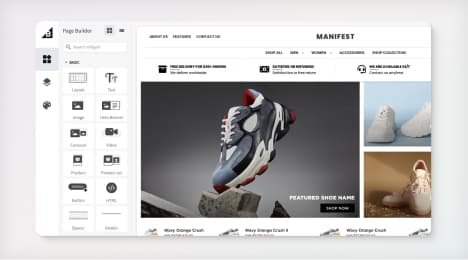
Watch Our Product Tour
See how BigCommerce helps you build and manage your online store with ease.
- Ecommerce Insights

6 Key Steps to Launch Your Online Store
Explore our Launch Foundations series to get your BigCommerce store up and running quickly.
BigCommerce helps growing businesses, enterprise brands, and everything in-between sell more online.
What are Product Performance Analytics?
Analytics are incredibly useful in every part of your ecommerce business. The data you collect helps you understand your visitor behavior and which day of the week is your biggest revenue generator. But if you're not looking at data directly related to your product performance, keep reading to learn more about what this kind of analytics is and how it can make a big difference in your decision making.
Defined: Product Performance Analytics
Product performance analytics is the collection and strategic analysis of data points (metrics) related to the purchasing funnel like how many times visitors view a product page, how many times a product is left abandoned in a cart, how many times a particular product gets to checkout, unique purchases, and more.
These metrics that are gathered on a per product basis can tell you a larger story about your entire product portfolio! Many people neglect this level of analysis because they aren't sure why or how they should do it.
Why Product Analytics Are Important
There’s one major reason that product performance analytics are important for ecommerce brands: they help you increase sales and improve overall operations.
1. Understand the product funnel
Product performance analytics, at their core, help you understand how well a product moves through the buying funnel. So from first impression to final purchase. No products are created equal, so it is really important to see which categories of products are more or less likely to be abandoned before checkout. Armed with this information, you can identify which products might be generally poor performers or are being snatched up by competitors in comparison shopping.
2. Make better merchandising decisions
Once you understand which products need help making it to checkout, it becomes easier to figure out why. For example, the real estate your product holds on your store could be directly related to the number of sales it has. You can begin to change the layout of your store to optimize navigating to a particular product. You can showcase collections or build out your recommended products section. Another problem often discovered is that the product images or descriptions aren't robust enough. You can tweak product pages to include in-context images, product demo videos or more detailed product descriptions. With the analytics, you will be able to see the impact of your merchandising efforts play out and learn how to best optimize your product performance overall.
3. Avoid stockouts
Inventory tracking is an important part of product performance analytics. Seeing in the moment how many items are being sold can help you forecast stock needs and work more efficiently with suppliers. This kind of performance data becomes more valuable when you couple it with regional or seasonal sales data. Many bigger brands and retailers also share this kind of point of sale data so that they have a more global view of who needs what and when. Being out of stock, if not a strategic choice, is frustrating for everyone.
4. Understand and plan marketing efforts
By tracking performance at a product-level, this lets you see how marketing and promotional efforts impact sales when showcasing different products or images. Let's say for example you promote a brand new handbag on Instagram for a set period of time. If you are tracking that handbag's performance over time, you will be able to see if that advert had any immediate effect on sales and how long after the promotion ended that they evened out. With product performance metrics available to slice and dice, you can also identify products for promotion faster, easier, and more systematically.
5. Identify opportunities to boost revenue
The end goal of running an ecommerce store is to generate revenue. Product analytics make it easier to identify opportunities to do just that. If you are tracking first time purchases versus recurring purchases, for example, you might discover products that may work really well on a subscription basis like laundry detergent or coffee capsules. If you track category impressions and store search, you could find out that your customers aren't finding a particular product they want and you could stock. Then of course, all the tests you can run with pricing, merchandising, and promotions are enough to help you optimize your overall web store profit!
How to Track Analytics
The first step is to start tracking. Analytics only make sense when there are enough data points to analyze. The ideal situation is to have a single platform where you can see and report on your data so that it becomes something enjoyable instead of a chore. For product performance there are two main ways to get started:
1. Built-in Analytics on Your Ecommerce Platform
The ecommerce platform you choose will likely have built-in analytics that you can use to get started. If you have an existing ecommerce platform, do a little research to see what they offer. Otherwise, when researching platforms look for ones that help you track performance. This is a great investment for the long term success of your ecommerce business.
2. Ecommerce Analytics Software Providers
You can also search for software services that track and consolidate ecommerce data. It goes without saying, Google Analytics Enhanced Ecommerce is the best way to start if you're looking for something external. It is free and usually integrates with your shop system. This option usually requires either a plugin to your ecommerce platform or a bit of coding (inputting a script to your store).
Types of Product Performance Metrics
How do you collect the right product performance metrics? Start small and targeted with a single goal in mind, then expand as you learn the ropes. Once you have a question you want answered, you can figure out which metrics will help you answer it. Here are just some basic metrics that can get you started:
1. Impressions
Impressions are how many times someone has viewed a particular thing. So for example a product detail page impressions are how many times a person has seen the individual product page. This includes things like product listing views, how many times a product made it to the shopping cart, checkout views and more. These are basic metrics that are building blocks for other types of analysis like conversion rates.
2. Conversion Rates
Conversion rates tell you the percentage of successful movements between different stages. Cart to Buy rates for example tell you what percentage of products made it from the shopping cart to a successful purchase. The opposite here of course is the ever-popular abandonment rates. If your conversion rate is 40% your abandonment rate is 60%. Conversion rates are crucial in identifying weaknesses in your buyer journey and purchasing funnel.
3. Unique vs. Recurring Purchases
This metric answers the question: "Do I have returning buyers?" You can spend a lot of money attracting visitors to your store, but if they come and then leave to never return, you need to figure out why. Before you can do that, you need to find out if it is even a problem.
4. Average Order Value
This is an interesting one. When taken as a standalone, your average order value can tell you how much people generally spend on a single visit to your store. But when you couple this metric with product-level detail, you can uncover which products impact your average order value more or less. Imagine you sell running shoes that whenever someone buys them they are more likely to also buy accessories like a fitness watch or running shorts. There can be a lot to be learned here when also taken with demographic data (which regions have higher AOV), metrics like average cart size, or other contextual pieces of information.
5. Sales vs Returns
Tracking which specific products come back to you is critical. The return rate will help you understand if your product listing is poorly designed (maybe the sizes or colors are off) or there is a deeper defect in the product. When you gather return data, also make sure to pick up on the qualitative data (what your customers say) so that the returns can be analyzed and the problems fixed.
Conclusion
Where many ecommerce stores focus on general metrics like purchases, revenue, and visitors, there is a lot to be learned when adding in product-level insights. Product performance analyticsare a critical part of optimizing your ecommerce operations, from web store management to sales and marketing. They give you deeper insight into what works. It is easy to get started with the tools available on the market and if you focus on a small set of metrics to start with, you can learn quickly. Want to learn more about this, as well as other ecommerce tips, trends, and news? Visit the BigCommerce blog today.
This blog post was contributed by Emma Kobylenski, Product Manager, Plytix.
BigCommerce helps growing businesses, enterprise brands, and everything in-between sell more online.
Start growing your ecommerce business even faster.
High-volume or established business? Request a demo